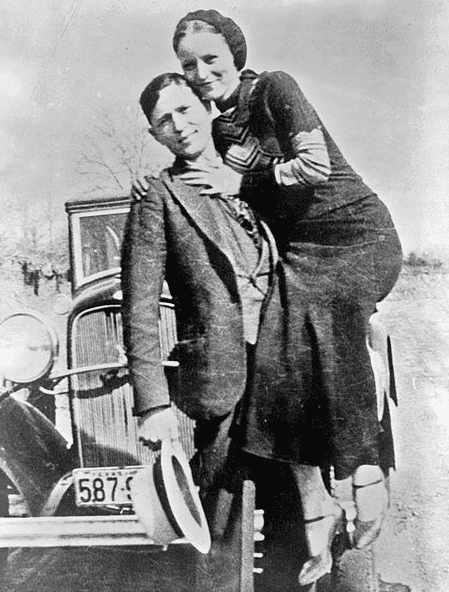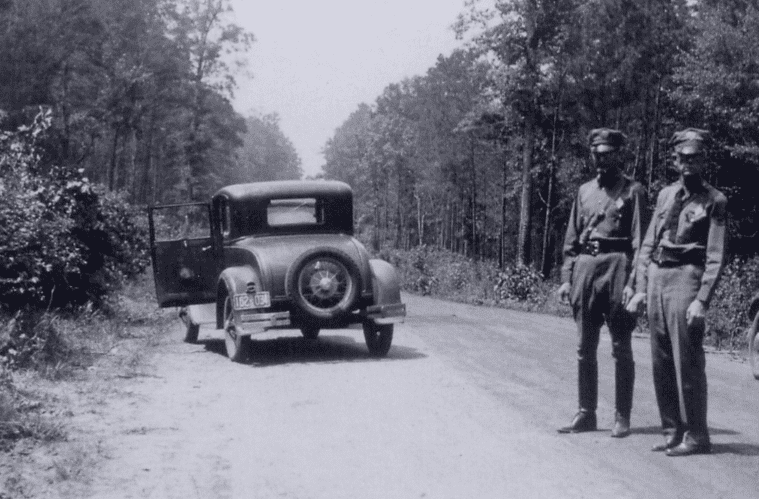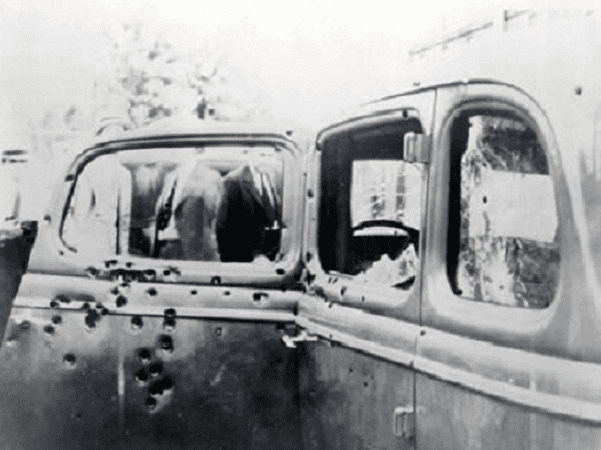Hollywood is notorious for simplifying and glorifying stories about outlaws (think of the 1969 film Butch Cassidy and the Sundance Kid with Paul Newman and Robert Redford), and the movie Bonnie and Clyde is part of that tradition. This 1967 film, starring the handsome duo of Faye Dunaway and Warren Beatty, portrayed Bonnie and Clyde as reckless and daring, madly in love with a devil-may-care approach to life and crime. The reality is far less glamorous.

Clyde Chestnut Barrow (1909-1934) was a cold-blooded killer; he and his gang murdered at least nine law officers and several civilians during a two-year crime career that included several highly publicized bank robberies – but more often targeted small stores and gas stations, and several of the gang’s victims were store personnel and gas station attendants. While Bonnie Elizabeth Parker (1910-1934) probably never killed anyone, she was an accomplice to many of the crimes and some of the killings.
Bonnie was 23 and Clyde 25 when they were ambushed by a posse on rural Louisiana State Highway 154 at 9:15 on the morning of 23 May 1934. The posse pumped approximately 130 bullets into the stolen car at Clyde, the driver, and Bonnie, the passenger. Even after the car crashed into an embankment, the lawmen continued firing into the car, not willing to take any chances. The coroner’s report said Clyde was hit 17 times and Bonnie 26.

Two weeks before she was killed, Bonnie visited her mother for the last time and handed her a poem she wrote (Bonnie had been a gifted student and writer in high school) entitled “The Trail’s End.” It concludes with these haunting lines:
They don’t think they’re too smart or desperate;
They know that the law always wins.
They’ve been shot at before;
But they do not ignore,
That death is the wages of sin.
Some day they’ll go down together
They’ll bury them side by side.
To few it’ll be grief,
To the law a relief
But it’s death for Bonnie and Clyde.
They certainly did “go down together,” but they were not buried “side by side”; Bonnie’s family would not allow it.
The following four newspaper articles give a less-glamorous portrayal of the two outlaws than the 1967 film presented. The first is a news account of their gory end; the second recounts Clyde’s many killings; the third gives the reaction of Bonnie’s estranged husband; and the fourth is an editorial from a Dallas paper, where Clyde’s crime career started with a booking in 1926 when the 16-year-old was arrested for not returning a rental car on time.
Here is a transcription of this article:
Barrow and Bonnie Parker Shot Dead from Ambush
Riddled by Texas Officers
Public Enemy Fails to Halt Speeding Automobile
Car Wrecked, Bodies Inside
ARCADIA, La., May 23. – (AP) – Clyde Barrow and his gunwoman companion, Bonnie Parker, were beaten to the trigger pull by Texas and Louisiana officers today.
Their crime career ended in a blaze of riot-gun fire when, disregarding a command to halt and unable to get their weapons into play, the desperado and his cigar-smoking girl crumpled up in the front seat of a car traveling about 85 miles an hour.
The car careened into an embankment and was wrecked.
In the wreckage, the officers who had set the trap for the Southwest’s Public Enemy Number One and the Parker woman found both bodies riddled with bullets. Bonnie’s was almost doubled over the machine gun she had held in her lap. Barrow’s broken body was twisted behind the steering wheel, a revolver gripped in one hand.
The car, splintered by gunfire, proved to be a speeding arsenal.
The trap was sprung by Frank Hamer, a former Texas Ranger; B. M. Gault, a highway patrolman; and Ted Hinton and Bob Alcorn, Dallas County sheriffs. Hamer was recently commissioned as a highway patrolman for the special purpose of getting his man – and, in this case, his gunwoman.
Hamer had learned of the highways frequented by the pair and had been watching for weeks.
Hamer and Gault had been watching the Black Lake hideout for two months.
Barely Missed Them
Several weeks ago, they barely missed the couple at the rendezvous. After that, they adopted a policy of “sitting and waiting.”
The bandits’ trail was picked up today by Hamer and three Texas Ranger associates in Rossier Parish, where Barrow was reported to have relatives. They followed the bandit car to Bienville Parish, where the Rangers were joined by Sheriff Henderson Jordan and a staff of deputies.
The officers got ahead of the bandit car and lay in wait until Barrow ran his machine into the ambush.
With the posse, heavily armed, hiding in brush along the paved highway, Barrow’s car broke over the horizon racing at 85 miles an hour. As it approached, an officer yelled, “Halt.”
Barrow and the woman answered by reaching for their guns. They were met by a fusillade from a dozen weapons.
The automobile smashed into an embankment. The officers continued to fire until the bodies were riddled.
Barrow and his companion had led peace officers on a wild chase over half a dozen States. Frequently they were cornered, but either eluded their pursuers or shot it out. They replenished their funds by robbing banks and business houses.
Reports that three other bandit companions of Barrow and the Parker woman had been slain were denied by officers on the scene.
Ready to Shoot Instantly
Barrow was regarded as one of the nation’s most dangerous killers, shooting at the bat of an eye and fleeing in fast automobiles.
Bonnie Parker was charged with participation in most of Barrow’s later crimes. Officers said she was as quick on the trigger as her associate, and just as elusive.
The bodies are being taken to Arcadia, La., 17 miles east of the scene of the killings.
In the wrecked car officers found three army rifles, two sawed-off automatic shotguns, a machine gun, a dozen pistols and large quantities of ammunition. Hamer’s laconic report read:
“We killed Clyde Barrow and Bonnie at 9:15 this morning. They were at Black Lake, a hideout we had been watching for weeks. Clyde and Bonnie did not get to fire a shot. Their car was full of guns and ammunition, but they did not get a chance to use them.”
Here is a transcription of this article:
Clyde Barrow Blazed Trail of Murder in Southwest
By Associated Press.
DALLAS, Tex., Wednesday, May 23. – Clyde (Champion) Barrow, the Southwest’s No. 1 public enemy, was wanted in connection with at least a dozen killings throughout the Southwest, on several of which he faced formal charges of murder.
His police record dates from 1926, when he was arrested in Dallas for automobile theft. In 1930, still known only as a minor hoodlum, he was sentenced to the Texas penitentiary for fourteen years on burglary and theft charges.
Early in 1932 he was granted a general parole by Gov. Ross Sterling, shortly thereafter embarking on his spectacular career of armed robbery and terrorism.
Here are some of the crimes for which Clyde Barrow, either alone on in company with his brother, Marvin, killed by officers in Iowa in 1933, was wanted:
April 30, 1932 – Murder of J. W. Bucher, filling station operator at Hillsboro, Tex.
August 5, 1932 – Murder of Deputy Sheriff E. C. Moore at Atoka, Okla.
October 11, 1932 – Killing of Howard Hall, grocery clerk at Sherman, Tex.
December 25, 1932 – Killing of Doyle Johnson at Temple, Tex.
January 7, 1933 – Killing of Deputy Sheriff Malcolm Davis in Dallas.
April 13, 1933 – Slaying of Constable J. W. Harryman and Detective Harry McBinnis at Joplin, Mo.
June 23, 1933 – Killing of Marshal Henry Humphrey at Van Buren, Ark.
January 16, 1934 – Killing of Major Crowson, guard at state prison farm near Huntsville, Tex., when Barrow allegedly staged a raid in which Raymond Hamilton, convicted killer and bank robber, and four other convicts were liberated.
April 1, 1934 – Killing of E. B. Wheeler and H. D. Murphy, Texas highway patrolmen, near Grapevine, Texas.
April 6, 1934 – Killing of Constable Cal Campbell at Miami, Okla.
Bonnie Parker, Barrow’s companion on many of the forays, was charged by officers with active participation in many of the crimes. She was believed to have been with Clyde and his brother, Marvin, when a posse cornered the gang near Dexter, Iowa, July 24, 1933. Clyde and Bonnie eluded officers but Marvin was fatally wounded.
Photographs retrieved by officers from hideouts of the gang showed the Parker woman fondling high-powered firearms and smoking cigars. To an officer whom she and Barrow kidnapped and held captive for a time, however, Bonnie denied she was addicted to tobacco in that form. The pictures had been taken as a lark, she asserted.
Here is a transcription of this article:
Glad She Died like She Did, Roy Thornton, Bonnie’s Spouse, Says
HOUSTON, Texas, May 23 – (AP) – Roy Thornton, 25, convict husband of Bonnie Parker, wily gunwoman, who was slain with Clyde Barrow near Arcadia, La., Wednesday, said he was glad his wife died as she did.
“I’m glad,” he said, “they went out like they did. It was better than getting caught.”
Capt. Ike Kelly, manager of the Retrieve prison farm where Thornton is serving a long sentence for robbery, asked Thornton if he had anything to say.
“I’m no snitcher,” Thornton sneered, “that’s all.”
Thornton previously said he had not seen Bonnie since 1931, when he was sentenced to sixty years in prison. Two months ago Thornton was shot in an attempt to break from the Huntsville State prison.
Here is a transcription of this article:
Wages of Sin
There has been no question in the minds of the law-abiding that the sinister careers of Clyde Barrow and Bonnie Parker would end either in the death chair or at the hands of a posse. The only question was when. That has been answered now – not soon enough to have preserved useful lives and property already lost – but with the inevitable comparative speed that overtakes all of their kind. Not in the harsh Mosaic code of the Old Testament, but in the unerring philosophy of the New is found the somber reflection of Paul that the wages of sin is death.
The Barrow-Parker finale cuts a notch on the gun of relentless law, this time tracking down the criminals, cornering and finishing them. The State and Nation owe a debt of thanks to Sheriff Henderson Jordan of Arcadia, La., the Dallas County law officers and a former State ranger who ably finished the job. The community owes a debt to itself and to posterity to see to it, by injunction if need be, that no show is made of the interment of the brutal pair who have met a fate that they deserved.
To what throwback in humanity or flaw in civilization the world owes its Barrows and Dillingers can only be conjectured. It is an evil outcropping whose example spreads and will spread, until juries act sternly to convince the erring that property and life are sacred and punishment speedy and severe.
Note: An online collection of newspapers, such as GenealogyBank’s Historical Newspaper Archives, is not only a great way to learn about the lives of your ancestors – the old newspaper articles also help you understand American history and the times your ancestors lived in, and the news they talked about and read in their local papers. Have you uncovered the stories of any outlaws in your family tree? Please share your stories with us in the comments section.
Related Articles:
